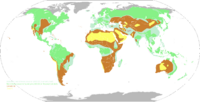

Animal husbandry is a form of agriculture that ... Although animal husbandry has several negative effects (see below), some areas naturally have (or had) open grasslands and are are not the native region of specific (plant-based) protein-foods (ie tofu, ...). Due to this, in these circumstances, growing animals may be appropriate. It however should be used only as a last resort.
In the map on the right, you can notice the appropriate locations were this can be done. The animals should be fed only with grass, the growing of other crops (ie maize, soy, grain, ...) would make the approach unappropriate and highly inefficient (these other -imported- crops would then be best eaten by the person itself). Note that one of the main reasons why the growing of animals can be appropriate in some situations at all is simply due to the presence of protein in the meat, calories can often be attained from other plants that can be grown in the region.
The other map on the right shows the native animal species that can be used per region. Cattle is discarded alltogether since it isn't a native animal anywhere (it is a species crossed by the human population, from the aurochs -itself now extinct-).
Pro and cons of animal husbandry
- creates huge methane emissions (90 millon tons worldwide, appearantly 510 million tons is sufficient to kill everyone on the planet, ie due to climate change)
- can transfer disease, unappealing practice of slaughtering
- wasteful method (energy is lost in conversion of grass to meat)
- very labour-intensive and (depending on what it's compared against, low-yield) method of protein production
- can disrupt the local ecosystem by taking up allot of space and prventing the housing of other animal and plant species
- ethical considerations by certain individuals
Slaughtering and processing
The animal needs to be slaughtered and processed in such a way that most of the animal can be used. There is always a degree of waste (unusable animal parts), and not all animal parts are as healthy/tasty. See Butchering a Beef (Bittersweet, Volume VII, No. 1, Fall 1979)
See also
External links
- http://en.wikipedia.org/wiki/List_of_domesticated_meat_animals
- http://en.wikipedia.org/wiki/Ungulates
- http://en.wikipedia.org/wiki/Beef_cattle
- http://en.wikipedia.org/wiki/Cattle
- http://en.wikipedia.org/wiki/Bovinae
- How to Direct Market Your Beef - Download this 96 page book free as a PDF file.
- How to Direct Market Your Beef" portrays how one couple used their family's ranch to launch a profitable, grass-based beef operation focused on direct market sales.